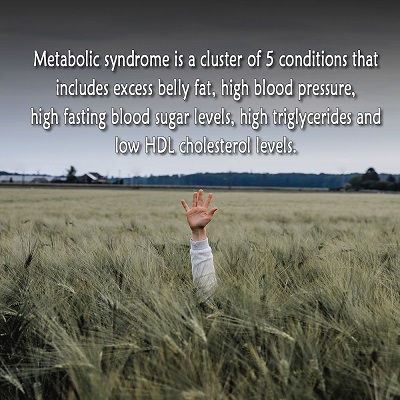 Metabolic syndrome is a cluster of conditions occurring simultaneously. These conditions put you at a greater risk of developing heart disease, stroke, and type 2 diabetes. The cluster of conditions includes excess belly fat, high blood pressure, high fasting blood sugar levels, high triglycerides, and low HDL cholesterol levels, which is the good cholesterol you need for health.
Metabolic syndrome is a cluster of conditions occurring simultaneously. These conditions put you at a greater risk of developing heart disease, stroke, and type 2 diabetes. The cluster of conditions includes excess belly fat, high blood pressure, high fasting blood sugar levels, high triglycerides, and low HDL cholesterol levels, which is the good cholesterol you need for health.
The presence of just one of the conditions mentioned is serious enough, but having only one doesn’t cause a diagnosis of metabolic syndrome. However, if a person has at least three of these five conditions simultaneously, that person may be diagnosed with metabolic syndrome and has a greater risk of developing cardiovascular diseases, like heart disease and stroke.
Laboratory tests are used to diagnose metabolic syndrome. It is not something anybody can self-diagnose or conclude in the lack of these necessary tests.
Metabolic syndrome is also known as Syndrome X, insulin resistance syndrome, or dysmetabolic syndrome.
It is defined by the World Health Organization as ‘a pathologic condition characterized by abdominal obesity, insulin resistance, hypertension, and hyperlipidemia.’
Considered a major health hazard today, a large percentage of adults are considered to have metabolic syndrome in many western countries, and the majority of them are aged 60-70 years of age. As people age, the risk of developing metabolic syndrome rises.
Developing any of the abovementioned health-related conditions puts a person at a greater risk of metabolic syndrome. These are typically the five major factors to look out for, and developing at least three of these conditions together can lead to a diagnosis of metabolic syndrome.
Having Excess Belly Fat
Being overweight or obese increases the risk of metabolic syndrome. An increased amount of fat around the waist or the abdomen area can be the most noticeable sign of this. A waist circumference of 35 inches for women and 40 inches for men can mean serious health consequences.
The fat itself is not the problem, but the location of the fat in the abdominal cavity signifies that it is wrapped closely around the vital organs. Fat around the waist is especially dangerous to heart health.
High Triglycerides
The conditions underlying metabolic syndrome are something that most people develop due to, or exacerbated by being overweight, obese, or lacking physical activity. Triglycerides are a type of fat contained in the blood, and perhaps you have heard of this term when having a cholesterol test.
The body creates triglycerides out of extra calories. If you’ve gained weight, especially, it’s important to know your triglyceride levels. Normal levels are below 150 mg/dL; borderline is within 150 to 199 mg/dL; and high triglyceride levels begin at 200 mg/dL above.
Try to keep your triglyceride levels below 150 mg/dL. If you can’t keep your triglyceride levels within a healthy range, then you are at a higher risk of developing metabolic syndrome, as well as type 2 diabetes. Treatments are available for lowering triglyceride levels, but the healthiest and most sustainable way is to watch your diet, lose weight (bodyfat), and get plenty of exercise.
Low HDL Cholesterol (The Good Cholesterol)
HDL cholesterol is the good cholesterol. LDL cholesterol is the bad cholesterol (in excess) that you want to keep at a healthy, lower level. Having high HDL cholesterol helps to remove the bad cholesterol from the arteries, helping avoid the risk of cardiovascular illness or heart disease.
It’s important to have adequate HDL cholesterol, which is why a person may be diagnosed with metabolic syndrome if these levels are too low and their LDL is too high. This also makes them more prone to heart disease. Losing weight and incorporating healthy lifestyle changes can help you increase your HDL cholesterol levels.
High Fasting Blood Sugar
Fasting blood sugar indicates how the body is managing blood sugar levels. Right after every meal, a person’s blood sugar level typically goes up. Depending on the diet, factors that lead to a spike in blood sugar are things like consuming large amounts of food, especially sugary foods or drinks, and foods that are full of simple carbohydrates, like bread or rice.
As blood sugar rises, the body’s pancreas releases the hormone insulin to lower the blood sugar. It breaks it down and stores it for later use. In a healthy body, insulin regulates your blood sugar levels and keeps them at a healthy range. In some instances it fails to do this process successfully, leaving your body with consistently high blood sugar.
High fasting blood sugar or anything beyond 100 mg/dL can lead to metabolic syndrome.
High Blood Pressure
The force of blood pushing through your arteries while your heart pumps is known as blood pressure. High blood pressure can result from a buildup of plaques in the arteries, which narrows and hardens the arteries, putting you at more serious risk of heart attack or stroke.
A blood pressure reading that is higher than 130/85 could lead to metabolic syndrome. To naturally lower blood pressure levels, maintain a healthy weight, exercise regularly, stop smoking, and maintain a low-sodium diet.
Metabolic syndrome is preventable, and its prevention involves focusing on not developing or worsening any of the conditions that contribute to it.






